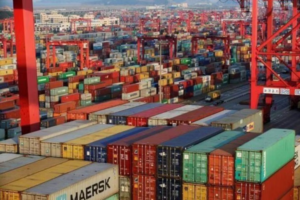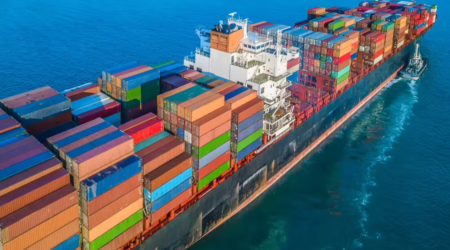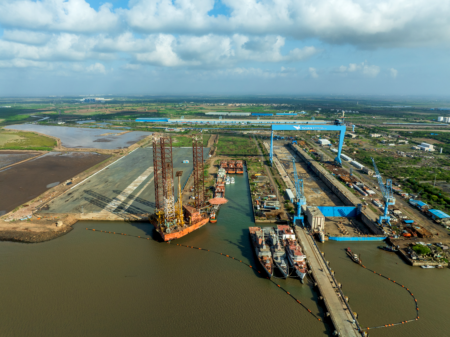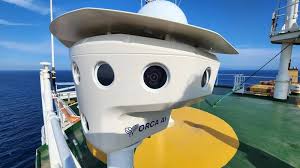The SCI-led JV, targeting a Dec 2025 launch, aims for 2-3x revenue by operating 58-59 ships, says CMD Capt BK Tyagi.

The soon-to-be incorporated joint venture company of Shipping Corporation of India, Indian Oil Corporation, Bharat Petroleum Corporation (BPCL), and Hindustan Petroleum Corporation (HPCL), which intends to purchase and operate ships primarily for the use of state-owned oil marketing companies, is expected to receive a 10% stake from the recently established ₹25,000 crore Maritime Development Fund (MDF) as its first investment.
With an investment of up to 15,000 crore over the next five years, the joint venture headed by the Shipping Corporation of India plans to purchase about 59 ships of various types, including very large crude carriers, very large gas carriers, Suezmax and Aframax tankers, medium-range tankers and offshore vessels, through a combination of second-hand purchases from the market and newly built vessels from Indian yards, according to a top official.
The oil marketing businesses have reduced their ship requirements from 112 ships to 59 ships for the next ten to fifteen years, according to a source on Monday.
During a conference call on Monday to discuss the company’s financial results for the second quarter of FY26, Capt. B K Tyagi, Chairman and Managing Director of the Shipping Corporation of India, informed analysts that SCI would own 50% of this JV that is being incorporated, 40% would come from IOC, BPCL, and HPCL, and 10% would come from the Maritime Development Fund.
A ₹25,000 crore Maritime Development Fund, consisting of a ₹20,000 crore Maritime Investment Fund with 49% government equity and a ₹5,000 crore Interest Incentivisation Fund with up to 3% interest incentive, was approved by the Union Cabinet in September. The plan approved by the Cabinet states that the Maritime Development Fund will use a hybrid finance strategy to draw in private investment.
The goal is to establish the joint venture company by December of next year.
We are preparing the technical requirements and tender terms concurrently.
“It is anticipated that we will be issuing invitations to tender for a selection of vessel types next month, which are currently being reviewed with the prospective JV partners,” stated Capt. Tyagi. This will include both newly built and second-hand vessels.
The JV venture has been encouraged by the government to assist local yards in obtaining orders for new ships. Capt. Tyagi declined to speculate about the proportion of new and used ships that the company will purchase.
“That breakup isn’t accessible yet. The JV company is now being incorporated. SCI will participate in the decision-making process after the JV entity is established, he stated.
However, the JV business will take a multifaceted strategy to purchasing ships, which will be owned and managed by Shipping Corporation in exchange for a management fee from the JV company.
“It would take three or four years to order and deliver a new vessel. Our goal is to swiftly expand our fleet. Purchasing some used boats from the market is the simplest method. This is just what we at SCI are doing by buying two extremely large, used petrol carriers. The JV will also employ a similar strategy, Capt. Tyagi said.
When the JV business is created, it will choose which of the 59 target ships to buy initially. The internal rate of return will be used to test this. If the vessel purchases are reasonable and clearly exceed 10 to 11 percent IRR, the JV board will accept them. These 59 ships will be dispersed over time, possibly during the next five years. The IRR test will undoubtedly be used to determine which vessel to buy first, according to Capt. Tyagi.
He explained that the JV’s core idea is that the oil companies needing to transport cargo will provide a firm commitment to the JV, ensuring all its vessels are fully engaged by them.
The JV entity wants oil corporations to commit to the JV vessels on a long-term (cargo) basis. In addition to a ‘plus-minus’ for which a formula would be developed, the freight or charter hiring prices would be connected to the current market indices for various categories, such as petrol and crude oil. He stated, “It will be a very fair pricing mechanism so that there are no issues from any side.”
Ambition for revenue
The risk of purchasing ships at the height of the shipping cycle and any ensuing effects from a downturn in the freight market will be covered by oil firms’ long-term cargo commitment and guaranteed vessel utilisation.
The JV company aims to “at least make two to three times the revenue” by running 59 ships compared to what SCI is currently earning from operating 58 ships.
“We intend to operate the ships with a 50% operating margin. The goal is to have a suitable target and challenges. We can only place the bets after that,” Capt. Tyagi stated.
Capt. Tyagi used the fact that SCI’s present fleet, which is more than 15 years old, has “some disadvantages when we charter out the ships” to support his argument.
When compared to new vessels or those that are less than five or ten years old, we do not receive the greatest prices. Better charter rates and more money would undoubtedly follow if we get these 59 or so ships, if they are brand-new and more efficient,” he said.
The JV company’s equity structure, in which SCI owns a 50% share, will “ease up the situation for SCI for arranging funds” required to buy the ships.
“Basically, we will provide 50% of the funds as our stock in the joint venture to purchase the ships, and everyone else will contribute in accordance with their holdings. For ship purchases, we borrow 70% and use 30% of our own funds, which is customary in the maritime industry,” he stated.
This fiscal year, the Shipping Corporation has added two extremely large gas carriers to its own fleet. He expressed that they remain optimistic and bullish about adding more second-hand vessels to their fleet during the current financial year. Capt. Tyagi stated that it intends to add 10–12 vessels in FY27.
SOURCE – ET INFRA











